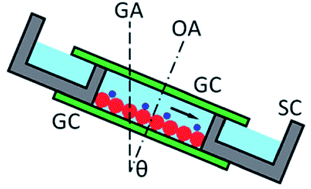Colloidal transport and diffusion over a tilted periodic potential: dynamics of individual particles
Abstract
A tilted two-layer colloidal system is constructed for the study of force-assisted barrier-crossing dynamics over a periodic potential. The periodic potential is provided by the bottom layer colloidal spheres forming a fixed crystalline pattern on a glass substrate. The corrugated surface of the bottom colloidal crystal provides a gravitational potential field for the top layer diffusing particles. By tilting the sample at an angle θ with respect to the vertical (gravity) direction, a tangential component of the gravitational force F is applied to the diffusing particles. The measured mean drift velocity v(F, Eb) and diffusion coefficient D(F, Eb) of the particles as a function of F and energy barrier height Eb agree well with the exact results of the one-dimensional drift velocity (R. L. Stratonovich, Radiotekh. Elektron, 1958, 3, 497) and diffusion coefficient (P. Reimann, et al., Phys. Rev. Lett., 2001, 87, 010602 and P. Reimann, et al., Phys. Rev. E, 2002, 65, 031104). Based on these exact results, we show analytically and verify experimentally that there exists a scaling region, in which v(F, Eb) and D(F, Eb) both scale as ν′(F)exp[−E*b(F)/kBT], where the Arrhenius pre-factor ν′(F) and effective barrier height E*b(F) are both modified by F. The experiment demonstrates the applications of this model system in evaluating different scaling forms of ν′(F) and E*b(F) and their accuracy, in order to extract useful information about the external potential, such as the intrinsic barrier height Eb.


 Please wait while we load your content...
Please wait while we load your content...